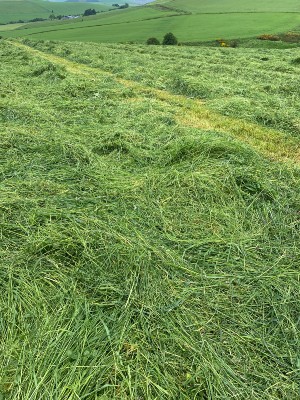High Nitrates in Silage
21 September 2021Silage that has had a late application of fertiliser or that was cut during the drought conditions this summer can contain elevated levels of nitrates. This can have a direct effect on the silage quality, particularly the fermentation resulting in reduced palatability and a drop in intakes. In rare serious cases of very high nitrates (>0.4%) caution is advised as the gases created during ensiling, can be converted to nitrous oxide, when this meets the air, it is converted to nitrogen dioxide which is harmful to people as well as animals.
The reason for minimising the nitrate-N content in forage is that it cannot be used as a nitrogen source by the animal. Nitrates in ensiled silage are converted to ammonia which increases the pH resulting in a slower, poorer fermentation which will affect palatability. High levels of nitrate may be converted to nitrite in the rumen which is toxic to animals. Nitrate-N is generally present in grass at around 0.05 – 0.15%, concentrations of 0.4% and above may be toxic to livestock. Note: the target at silage cutting for nitrate N is below 0.1%.
Nitrate –N % DM typically declines as follows after individual fertiliser dressings :-
| Weeks After N Application | ||||||
|---|---|---|---|---|---|---|
| N Rate kg N/ha | 1 | 2 | 3 | 4 | 5 | 6 |
| 28 | 0.13 | 0.02 | 0.02 | 0.03 | 0.03 | 0.04 |
| 84 | 0.33 | 0.39 | 0.08 | 0.05 | 0.03 | 0.03 |
| 140 | 0.33 | 0.65 | 0.54 | 0.15 | 0.10 | 0.08 |
The rate of decline will be somewhat dependent on growing conditions but would suggest that an:
- individual application of 28 kg N/ha it would be safe to harvest 2 weeks after application
- application of 84 kg N /ha it would be safe to harvest 4 weeks after application
- application of 140 kg N/ha it would be safe to harvest 6 weeks after application
What to do if you think you have high nitrate silage:
- Do not open silage until at least 4 weeks after ensiling to avoid disrupting fermentation
- Visual assessment – if silage has a dark green, ammonia smell it could be an indication of high nitrates
- Get the silage tested at a specialised forage lab that can test for nitrate-N
- Monitor their intakes, general health and performance and dilute with other lower nitrate forage if needed
- Speak to your vet/ nutritionist if you are unsure
Mary Young, mary.young@sac.co.uk
Sign up to the FAS newsletter
Receive updates on news, events and publications from Scotland’s Farm Advisory Service

